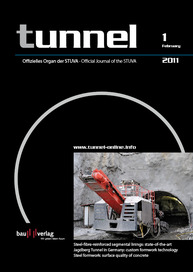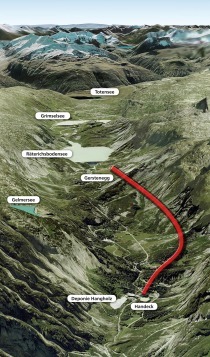The Lungern Bypass Tunnel – Breakthrough and initial fitting out
For the Lungern bypass tunnel, a 3.5 km long exploratory tunnel was first driven from north to south in 2000 – 2003 using a tunnel-boring machine (TBM, 4.75 m diameter). The tunnel route was then modified, as a fault zone had been discovered; in addition, new perceptions in operational tunnel safety have resulted in the retention of the exploratory tunnel for use as an escape tunnel, accessed by means of transverse tunnels at intervals of 250 to 300 m.
Then, for a good three years, a 3.57 km long two-lane tunnel bore (contraflow operation) was excavated using drilling and blasting (D&B) methods along an arc under the right mountainside (90 to 100 m²; 3 to 7 m/td) for the in all 4.3 km long A8 Lungern bypass. The breakthrough took place on July 2, 2010. In addition to the transverse tunnels leading to the escape tunnel some 20 m away in the rock, four double-sided emergency stop bays, plus SOS and fire-hydrant niches at intervals of 150 m, are provided in the tunnel, as well as the standard safety, monitoring and measuring systems including, in particular, all-round video monitoring of operation in the tunnel bore and the portal zones, with the video-signals relayed to the operating centre in Sarnen (ventilation-control and tunnel operating centres are located close to both portals). In case of fire, the combustion gases are extracted via flaps installed every 100 m in the false roof of the tunnel.
During tunnelling, the excavated material (around 0.6 million m³) was transported via a belt-conveyor in the exploratory/escape tunnel to the southern portal and, for the most part, on to the 400 m distant Hinti landfill; HGV traffic through Lungern town centre was thus avoided. A portion of the excavated material (some 70,000 m³) was crushed and is being used as in-fill material for the tunnel carriageway and as back-filling material for the portal structures. Upon completion, a total of some 0.13 million m³ of concrete will have been used for lining of the tunnel and escape tunnel, etc.
The AUL consortium consisting of Implenia AG, Aarau, Gasser Felstechnik AG, Lungern and Bürgi AG, Alpnach has been entrusted with the construction of this bypass tunnel.
Deadlines and costs
Further fitting out of this bypass tunnel will be necessary prior to its opening to traffic (tunnel roof, including sealing system, false roof, sidewalks, etc.); in addition, the road links at both portals remain to be completed. Also requiring installation are the operating and safety systems (power supply and tunnel ventilation systems), totalling around 40 million CHF (approx. 30 million EUR). The overall costs of the Lungern Bypass project are estimated at some 265 million CHF (195 million EUR), including 22 million CHF (16 million EUR) for the escape tunnel. Inauguration is scheduled for 2010, after a six-year construction period.⇥G.B


